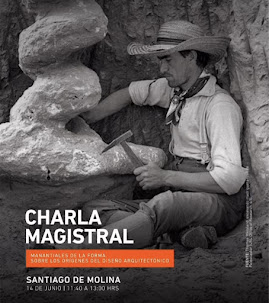Tal vez su pastosidad indefinida, entre lo líquido, lo gelatinoso y lo sólido, no ofrezca prestigio suficiente como materia para constituirse en el origen de una fenomenología seria. O tal vez su falta de buena fama sea fruto de vivir de una forma prestada llamada encofrado.
Es justamente en el acto de ser vertido cuando el hormigón se revela y muestra, pienso, el centro de su verdadero ser. Como una fiera blanda dispuesta a escaparse por los huecos más inverosímiles, los constructores tratan de menearla para que no deje huecos entre su grava, arena y cemento; tratan de controlar sus juntas y tongadas para que el resultado pétreo sea respetable, pero no resulta nunca sencillo y, la mayoría de las veces, acaba siendo algo viejo y churretoso aun recién acabado.
En el hormigón incontrolable hay una lucha de pericia semejante a la del domador de caballos salvajes. La mejor brida que se emplea para esa doma es la geometría. Y es en ese momento cuando aparece la fusta que la construcción denomina como junta de hormigonado.
Para evitar que aparezcan de forma aleatoria y dañina, se hacen unas ranuras especiales con formas de “V” o de “U” que guían dónde se formarán esas fisuras. Las juntas tienen esas formas, como es sabido, porque luego hay que sacar de allí la pieza que forma la junta sin romper las delicadas aristas del hormigón, (salvo Louis Kahn, que contra el sentido común las hace asomar). Estas ranuras, que se conocen coloquialmente como berenjenos, marcan límites: de las tongadas o de capacidad de la hormigonera.
Ignoro el porqué del hermoso nombre: berenjeno. Seguro que se trata de un localismo. Me divierte esa huerta de berenjenos plantada en el gris de un muro. Eso sí son huertos urbanos.
Perhaps its undefined viscosity—somewhere between liquid, gelatinous and solid—lacks the prestige to serve as the basis for any serious phenomenology. Or perhaps its poor reputation comes from living a borrowed life known as formwork.
It is precisely at the moment of being poured that concrete reveals itself and, I think, shows the core of its true nature. Like a soft beast ready to escape through the most improbable gaps, builders try to shake it into place so it doesn’t leave voids among the gravel, sand and cement. They try to control the joints and the pours to make the final stony result respectable, but it’s never easy—and more often than not it ends up looking tired and grimy even when freshly finished.
There is a craftsmanship in taming unruly concrete that resembles the training of wild horses. The best bridle used for this taming is geometry. And it is precisely then that the whip appears—what the construction trade calls the contraction joint.
To prevent random and damaging cracks, special grooves in the shape of a “V” or a “U” are cut to guide where those fissures will form. The joints have these shapes, as is well known, because later the piece that forms the joint must be removed without breaking the delicate edges of the concrete (except for Louis Kahn, who, against common sense, lets them show). These grooves, colloquially known as berenjenos, mark boundaries: either of the concrete pours or the mixer’s capacity.
I have no idea where this beautiful name comes from: berenjeno. Surely it’s a regionalism. I enjoy the image of that little patch of berenjenos planted in the grey of a wall. Now that’s urban gardening.














































































































No hay comentarios:
Publicar un comentario